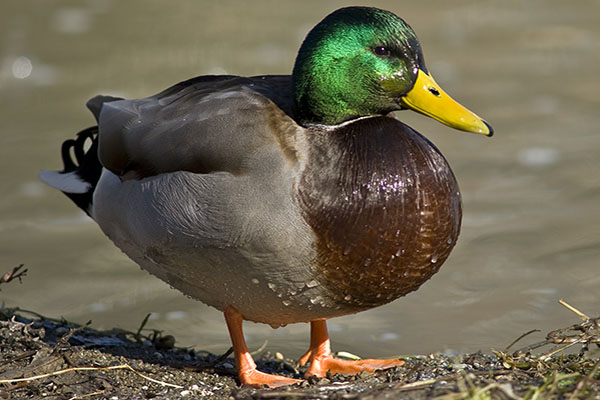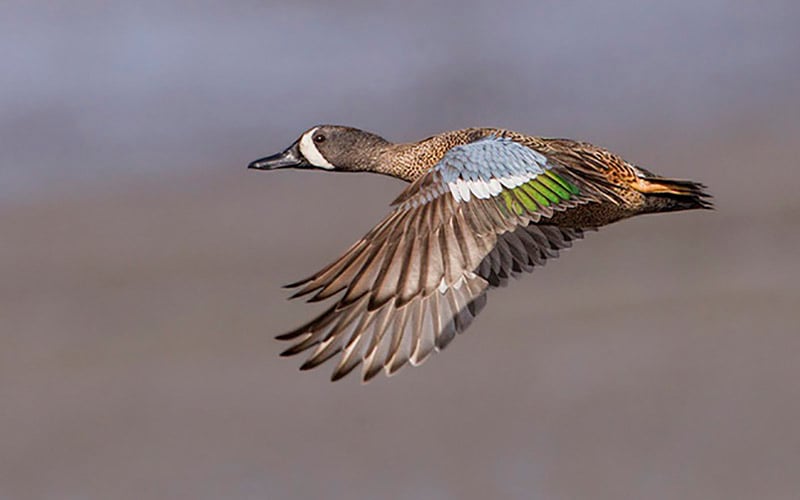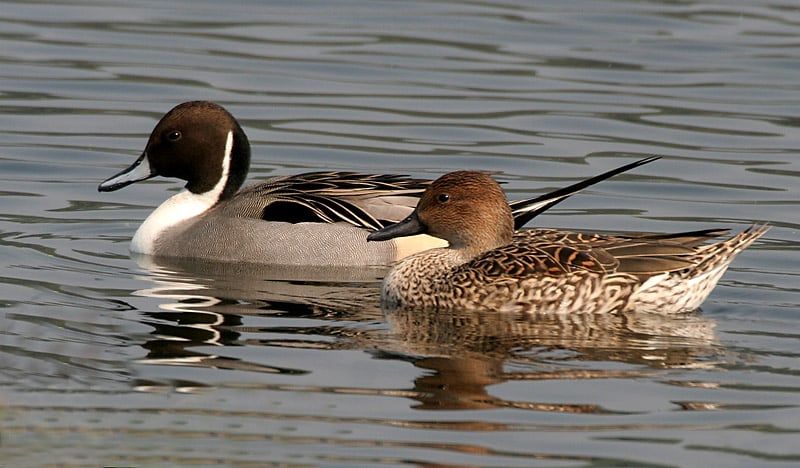
Last Updated on
Many of the most beautiful and abundant ducks in North America are dabblers (not divers). Learn what makes them different and how to better hunt them!
Every year, thousands of hunters across the country set up beside ponds, streams, wetlands and swamps to get their shot at a few of these beautiful game birds. Ducks provide some of the best hunting you can find. To gain the best odds of bagging these birds, it is important to know the different types and behaviors of duck species.
Dabbling ducks represent a group of ducks that focus on shallow water habitats and feed primarily from the surface of the water. They simple tip their bodies headfirst into the water to graze on aquatic vegetation. Although some dabblers may dive from time to time, this family of ducks does not use diving as an essential feeding behavior.
Dabbling Duck Species
Dabbling duck species are typically lighter and have the ability to take-off vertically from the water. They generally have smaller feet with legs that sit farther forward than diving ducks. These are a few of the more common dabblers:
Mallard
The Mallard duck is not only the most abundant species of duck in North America, but it is also the largest of the dabblers. The “greenheads” can grow to be just over 24” long at adulthood with a wingspan of 3 feet and a weight of 2 ¾ pounds. They have a hefty body style, round heads and wide bills. When in flight, a Mallard’s wings are broad and set back.
Male Mallards, or drakes, feature a distinctive iridescent-green head and neck with a yellow bill, white neck ring and a brown breast. Hens have a mottled brown body with an orange/black bill. Both sexes feature blue wing patches.
QUICK MALLARD FACT: The most well-known duck quacking sound comes from Mallard hens. Drakes do not quack at all. They make a much quieter, raspy sound.
Mallards almost never dive, but instead graze on shallow-water plant life like other dabbling duck species. They tend to stay in groups and can become quite tame in city park settings. In heavily-hunted areas however, Mallards quickly learn to stay away from people. “Greenheads” can be found throughout most wetland habitats in North America. Mallards can thrive in small beaver ponds, city parks, farms, prairie potholes, expansive lakes, marshes, estuaries and more.
Mallards are generalist foragers. They eat a wide array of different foods in the water and on land. During the breeding season, they stock up on protein by focusing on insect larvae, worms, freshwater shrimp and snails. During migration, they eat mostly agricultural seeds and grains.
Teal (Green-Winged and Blue-Winged)
While the Mallard claims the title for the largest of the dabbling duck species, the Green-Winged Teal represents the runt of the family. In fact, the Green-Winged Teal is really not much larger than a pigeon. Drakes feature brown heads with dark green patches that extend back from the eyes. They have a white vertical band that separates their brown-flecked chests from their more-grayish back and sides. Hens are mottled brown, but both sexes feature green wing patches.
The green-winged teal is a very hardy duck and will fly to some of the most northern areas of open water in North America. They prefer shallow ponds with abundant emergent vegetation. Coastal families look for tidal streams, mudflats and marshes with some open water.
The blue-winged cousin of the Green-Winged Teal can grow slightly larger, but is also considered a small duck. Blue-winged drakes feature a distinctive white facial crest and brown-spotted breasts and flanks. They have pale blue shoulder feathers and black rear feathers. Hens have a dark eye line, mottled brown body and more dull pale blue shoulder feathers. Blue-Winged Teal flocks are fairly small in numbers and often surprise hunters by flying low over marshland.
Northern Pintail
The slim, long-necked northern pintail probably has the most distinctive silhouette among the dabbling duck species. Many people believe that the Northern Pintail, with its long black tail, brown head, white neck stripes and gray body, is the most beautiful of the North American ducks.
Although the Northern Pintail’s long neck and tail make it seem larger than a Mallard, they are slightly smaller in both size and weight. Drakes have iridescent-green wing patches with light borders, a white chest, white neck strip and reddish-brown head. Hens are mottled brown with a dull wing patch. Both sexes feature long pointed tails, but drakes’ tails are typically longer. Eclipse plumage on the drakes is generally duller and more brownish all around.
Northern Pintails can be found across all four major flyways in North America, but they are more common in the western areas. They nest in fairly open country with seasonal wetlands and low vegetation. The pintails spend their winters in a vast range of intertidal and shallow inland habitats. Their diet varies from snails, crustaceans, and aquatic insects to weeds, seeds and grains.
The Northern Pintail is known for its fast and agile flying abilities. It is common to see them zig-zagging down from very high elevations before finally leveling off upon approach. They are also quite agile on land and spend a fair amount of time feeding in agricultural fields.
Gadwall
The understated coloration of the Gadwall drake can make it easy to overlook among the other species of dabbling ducks, but what the Gadwall lacks in color, it makes up for in extremely intricate patterns of brown, gray and black. Gadwall hens look a lot like Mallard hens, but feature a darker, thinner bill.
Although Gadwall are very similar in size to Mallards, they have noticeably thinner bills and more slender necks and wings than Mallards in flight. Gadwall often feed with other dabbling duck species and sometimes steal food from diving ducks and coots. They fly in small flocks, typically in a direct line, and use very rapid wingbeats.
Gadwall breeding grounds can be found throughout the Great Plains and prairies. They are most common along the Central Flyway and migrate earlier than many other duck species. In winter and during migration, they look for ponds, reservoirs, marshes, parks and muddy estuaries.
There are several other duck species that can be classified as dabblers, but many ducks known as dabblers also dive for food from time to time. The Mottled Duck, Cinnamon Teal, Northern Shoveler, American Black Duck, American Wigeon, and Wood Duck can all be classified as dabblers.
Hunting Tactics
Understanding the basic behaviors of the dabbling ducks can help you bring more down during hunting season. If you’re focusing on the dabblers, the first thing to note is their preference of shallow water areas around peninsulas, islands and creek inlets. Placing a spread and setting up over deep water may help you bag some divers, but you won’t get many dabblers.
As with any type of hunting, scouting for the best location is extremely important. By setting up in areas where you’ve seen ducks recently, you will greatly reduce your chances of having a hunt with no action. If you don’t have time to scout, take one day of hunting and split into a half-day of hunting and a half-day of scouting. Even a half-day can save you many future days of poor hunting.
Dabbling ducks look for slow-moving, shallow water for feeding and resting. Finding some land with these features not only looks more attractive to dabblers, but it also makes setting-out and picking-up decoys much easier. Typically, there are also more place to set up good blinds in these areas.
When it comes to calling in dabblers, there are many different tactics that work in specific situations, but one strategy seems to work best in a variety of scenarios. Although many duck hunters use feed calls to bring in nearby ducks, a series of short, low hen quacks works even better for guiding the birds into gun range. These quacks should be short, low-pitched and low in volume.
Dabbling ducks, and diving ducks for that matter, are fairly predictable most of the time. This predictability makes hunting feasible; however, that does not mean they will behave the same way every time. Any experienced dabbling duck hunter has a story, whether he tells it or not, about a time when he thought he finally had the ducks figured out, only to see them do something totally different the next day. All duck hunters are forced to eat some humble pie from time to time, but this uncertainty that makes the sport so much fun.
Gear and Equipment for Dabblers
As with any other game hunting, bringing the right equipment and gear for a dabbling duck hunt is extremely important. A good set of lightweight decoys should be considered essential gear. Make sure you get a variety of species in your decoy spread, and always check your decoy lines since they may break or ware out year-to-year.
Duck calls are very effective tools for luring the dabblers into your shooting range. A reliable mallard call is a great start, but depending on your hunting area, specialized Teal and Pintail calls can also be very helpful. Make sure you practice your calling skills, and call only to tips and tails!
A quality pair of waders, camo that matches the vegetation in your area, a choke tube that matches the average range of your shots, and a good hunting bag with snacks, essential tools and warming pads all represent other important pieces of equipment when you’re out hunting dabblers.








Comments (1)
Tony Martinssays:
September 11, 2015 at 2:07 pmNice piece Luke, and some nice images. We do quite a bit of jump and pass shooting where we hunt ducks in the west (mostly high elevation wetlands and streams in eastern AZ). Gadwall are one of my favorites to shoot and eat. Since they are primarily vegetarian the quality of their table fare is predictable. And, gadwall are almost always mixed with the also tasty and beautiful American widgeon (baldpates) where we hunt. Tony Martins